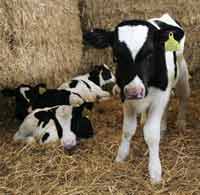Mycoplasma bovis going undiagnosed in dairy herds

Calf earache may not be routinely observed, but farmers should pay close attention to calf symptoms as they may be displaying signs of Mycoplasma bovis infection, says vet Neil Howie, Nantwich vet group.
“Mycoplasma bovis causes a whole host of disease problems including pneumonia, joint disease, conjunctivitis, mastitis or otitis (earache).”
Calf symptoms are just one part of a much bigger picture.
“I often see heifers calving down with seemingly good udders, but upon milking, a quarter fails to milk well. The question is why?”
If you are seeing a number of heifers with this problem and a high incidence of calf earache, Mycoplasma may be the problem, says Mr Howie.
“Look carefully at your calves. What appears to be pneumonia, may in fact be earache.”
To see if a calf has earache rather than pneumonia, stand with the calf’s head facing forward between your legs.
“Earache resembles a head cold. When looking at the head, the calf will look like a sick animal – often characterised by head tilt.
“However, when you look at the body in isolation, the calf will appear healthy.”
When the calf has pneumonia, the animal will be panting heavily.
Examine the ears and ear canals.
“Take hold of the base of the ear and gently manipulate – if you hear squelshing, there is an ear infection. The calf will also typically shake its head afterwards.”
Earache should be treated with pain killers and short, sharp antibiotic treatment.
When seeing a high incidence or other Mycoplasma signs, swabs can be taken from the ear for analysis.
Pneumonia
Pneumonic symptoms can also be a sign of Mycoplasma bovis.
25% of calf pneumonia cases are positive for Mycoplasma bovis, says Roger Ayling, research scientist for the Mycoplasma Group.
The age of onset of pneumonic type symptoms can be an indicator of Mycoplasma.
Pneumonia will usually occur in calves aged two-four months, says Aiden Foster, vet investigation officer, VLA Shrewsbury. “When seeing the onset of respiratory illnesses in younger calves, Mycoplasma may be the problem.”
And when seeing calf pneumonia and swollen joints at the same time, it has to be as a result of Mycoplasma, says Mr Howie.
Mastitis
Mycoplasma is a widely recognised cause of mastitis in the USA, says Dai Grove-White, lecturer at Liverpool Vet School. “I suspect, mycoplasma is an under diagnosed cause of mastitis in the UK – it’s a case of, if you don’t look, you don’t see.
“When experiencing high cell counts, a lot of untreatable mastitis and lost quarters, or unexplained swollen joints in adults that are unresponsive to treatment, Mycoplasma may be an issue.”
Mycoplasma spread
Mycoplasma is primarily spread via the respiratory tract, but there is some evidence to suggest transmission via milk, says Dr Grove-White.
“Calves ingesting mycoplasma-infected milk may develop respiratory problems, but equally, the bug may act on the udder causing future complications.
“This is one more reason why feeding waste milk is bad animal husbandry. I would advise pasteurisation of milk or feeding milk replacers.”
Treatment and control
The problem is Mycoplasma is not routinely tested by labs, says Dr Grove-White. “When mastitis is not responding to treatment and cultures have failed to identify normal mastitis causing bugs, then Mycoplasma may be the problem.”
When this is the case, talk to your vet about analysing for mycoplasma.
Mastitis caused by Mycoplasma bovis is incredibly difficult to treat, says Dr Ayling.
“Mycoplasma is becoming more resistant to antibiotic treatment. Correct antibiotic treatment can help if you treat early, but culling of severely infected animals may be an option to control disease spread.”
High standards of milking hygiene are also essential, says Dr Grove-White.
“Milk high cell count cows and mastitic cows last and implement a good teat dipping regime.”
